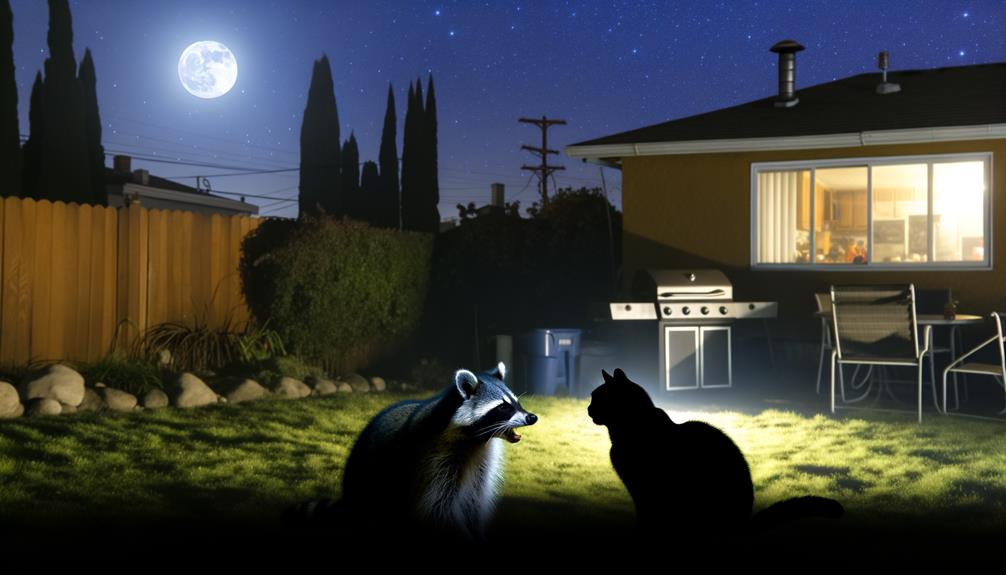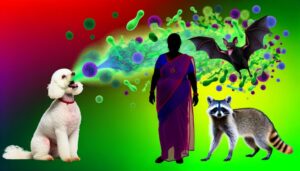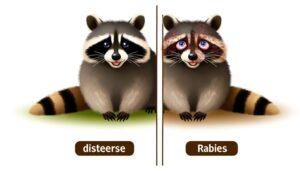Do Raccoons Sound Like Cats?
Raccoons and cats express a distinct range of vocalizations that communicate their emotions, issues of territory, or signal impending danger. Raccoons emit sounds that include growls, hisses, screams, chitters, and purrs, while cats often produce purrs, hisses, and meows.
Additionally, raccoons emit high-pitched trills and chirps while foraging during the night, which differ from typically feline sounds. Deciphering between these sounds necessitates a nuanced understanding of both species' communication needs and habits.
A more in-depth exploration into their unique life cycles and environments can provide compelling insights into their remarkable vocal repertoire.

Key Takeaways
- Raccoons and cats have different vocalizations, with raccoons often emitting growls, hisses, and high-pitched screams.
- Both species use sounds to express emotions and signal danger, but the specific noises they make are distinct.
- Raccoon sounds are more complex and varied than cat sounds, reflecting their adaptable nature and complex social interactions.
- Identifying raccoon sounds, like high-pitched screeches and chittering, can help distinguish them from cats.
- Understanding the nuances of raccoon and cat sounds aids in immediate identification and predicting behavior.
Understanding Raccoon Vocalizations
While it may be intriguing to compare raccoon vocalizations to those of cats, it is essential to understand that raccoons have a complex range of sounds uniquely adapted to their lifestyle and environment.
Raccoons use a variety of auditory signals for communication, including growls, snarls, hisses, and screams. These sounds serve multiple functions such as territorial defense, mating calls, and warning signals.
Raccoons also emit high-pitched trills and chirps that are similar to birdsong. These vocalizations are particularly prevalent during night-time foraging, underscoring their nocturnal nature.
These peculiar sounds are an intrinsic part of the raccoon's communicative repertoire, reflecting their adaptive acumen in diverse habitats, and highlighting the rich complexity of their social interaction mechanisms.
Cat Sounds Vs. Raccoon Sounds
In comparing the auditory signals of raccoons and cats, it becomes evident that there are distinct differences and similarities that reflect the unique lifestyles and communication needs of these animals. Cats typically produce sounds such as purring, hissing, and meowing, while raccoons emit a wider range of noises, including chittering and growling.
However, both species use vocalizations for similar purposes: expressing emotion, signaling danger, and communicating with their kin. The table below captures the basic differences and similarities in their vocalizations:
| Animal | Common Sounds | Purpose |
|---|---|---|
| Cat | Purring, Hissing, Meowing | Expressing emotion, signaling danger |
| Raccoon | Chittering, Growling | Expressing emotion, signaling danger |
Understanding these nuances can aid in distinguishing between these creatures' sounds, nurturing our respect for their communicative prowess.
Deciphering Common Raccoon Noises
Delving into the world of raccoon vocalizations, it becomes clear that these nocturnal creatures employ a fascinating array of sounds to communicate. Understanding these sounds, however, requires keen observation and patience.
Raccoons typically produce growls, hisses, and screams, reminiscent of felines, which often confuses listeners. A common noise is the 'chitter,' a rapid-fire vocalization used during social interactions. They also emit low-frequency purrs when content.
Alarm calls are unique; a series of harsh, raspy screeches signal danger. Nightly foraging is accompanied by smacking and crunching, revealing their location. This ability to vocalize complex emotions and intentions indicates a high level of intelligence and social organization, making raccoons one of the most vocally diverse mammals in their size range.
The Science Behind Raccoon Sounds
Peeling back the layers of raccoon communication, the science behind their diverse range of sounds reveals a complex and finely-tuned system of vocal cues, each with its own specific meaning and purpose. These sounds are not arbitrary but are instead driven by environmental factors, emotional states, and social dynamics.
Acoustic studies have shown that raccoons use a wide frequency spectrum, much like cats, and can modulate their tone and pitch to convey different messages. Their vocal repertoire includes purrs, growls, hisses, and even ultrasonic calls beyond human hearing range. These intricate acoustic signals communicate everything from territorial warnings to mating invitations, exemplifying the sophistication of raccoon communication.
Understanding these scientific fundamentals allows us to better interpret the languages of our wildlife companions.
Identifying Raccoons by Their Sounds
Recognizing raccoons by their distinct sounds is an essential skill for identifying their presence, particularly in urban environments where visual sighting might be limited.
Raccoons are known for their variety of vocalizations, which can range from purring, hissing, and growling to more complex chittering and screeching. These sounds, especially the high-pitched screeches, are very different from the typically soft meows or purrs of a cat.
A raccoon's vocalizations often serve as an essential cue to its behavior, such as whether it feels threatened or is looking for food. Understanding these unique sounds not only aids in immediate identification but also helps in predicting the creature's next move, giving people the freedom to respond appropriately and in a timely manner.
Conclusion
To sum up, the acoustic properties of raccoon vocalizations are distinct from those of feline communications. While some similarities exist, discerning the subtle nuances between the two can aid in accurate identification.
Understanding these distinctions is akin to distinguishing the subtle notes in a symphony, each holding its own unique significance.
Further research into the extent and intricacies of raccoon communication could facilitate enhanced cohabitation strategies between wildlife and humans in shared environments.






